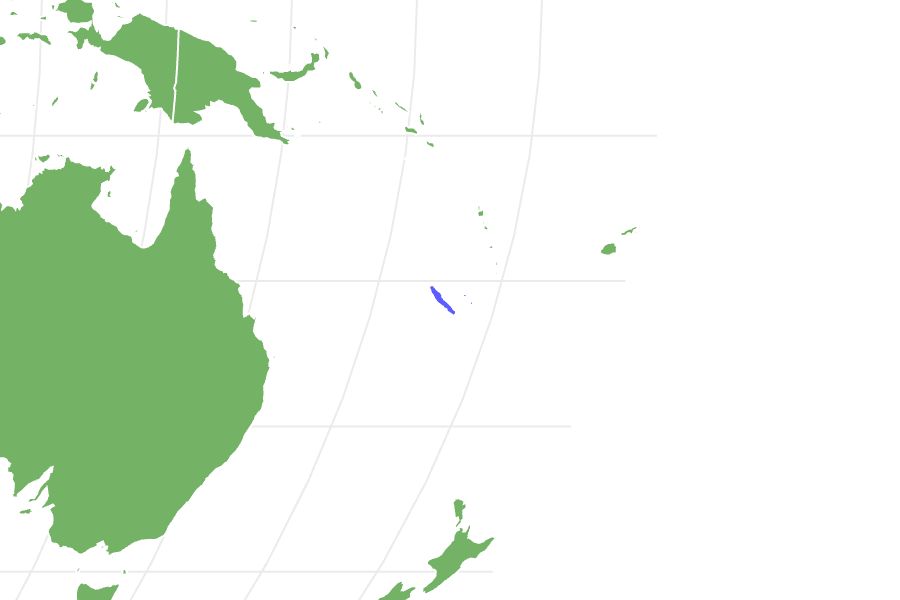Crested Gecko
Correlophus ciliatus
The crested gecko can walk on glass and even has a prehensile tail.
Advertisement
Crested Gecko Scientific Classification
- Kingdom
- Animalia
- Phylum
- Chordata
- Class
- Reptilia
- Order
- Squamata
- Family
- Diplodactglidae
- Genus
- Correlophus
- Scientific Name
- Correlophus ciliatus
Read our Complete Guide to Classification of Animals.
Crested Gecko Conservation Status
Crested Gecko Facts
- Prey
- Insects, arthropods such as spiders
- Name Of Young
- hatchling
- Group Behavior
- Solitary
- Fun Fact
- The crested gecko can walk on glass and even has a prehensile tail.
- Biggest Threat
- Habitat destruction, introduction of invasive species.
- Most Distinctive Feature
- The fringed crests that shade their eyes and run down the back and over the legs
- Other Name(s)
- New Caledonian crested gecko, eyelash gecko
- Gestation Period
- 90 to 190 days
- Litter Size
- two
- Habitat
- Rainforest from 492 to 3281 feet
- Predators
- Fire ants, dogs, cats, snakes, rats, other geckos
- Diet
- Omnivore
- Type
- reptile
- Common Name
- crested gecko
- Number Of Species
- 1
- Location
- New Caledonia
- Group
- solitary
View all of the Crested Gecko images!
“The crested gecko is known for its fake eyelashes ”
The crested gecko is also called the eyelash gecko because its large eyes are framed with delicate spines that look like cartoonish eyelashes. These spines continue down both sides of its body from the eyes to the tail. This little gecko is so adorable that it is a popular pet – even if it is endangered in its own native habitat.
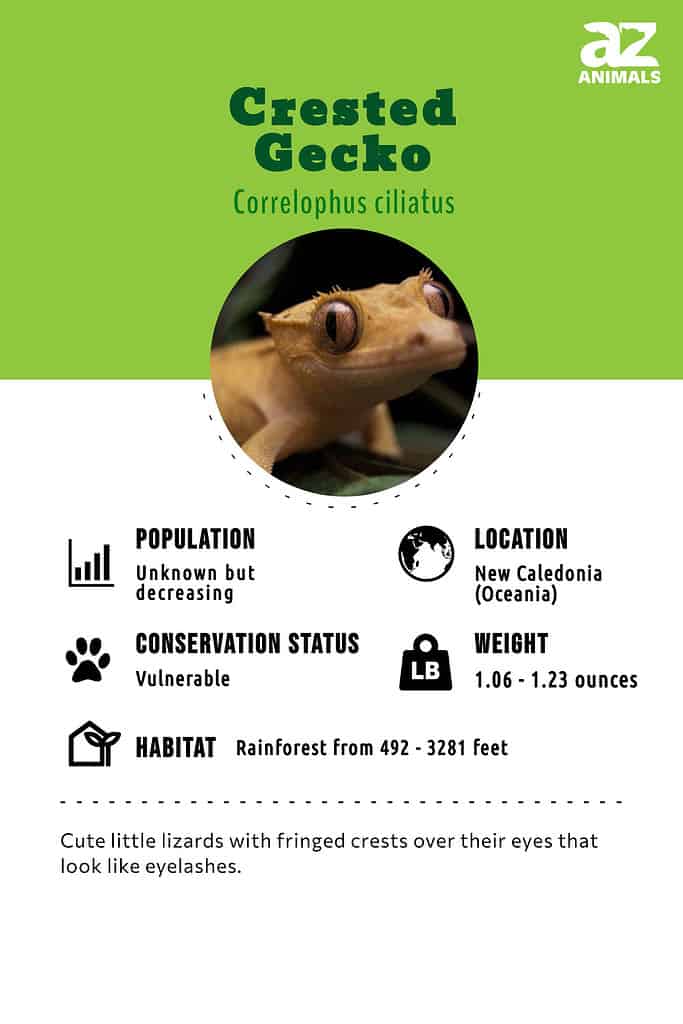
Fascinating Facts About the Crested Gecko!
- Unlike lots of other lizards, crested geckos’ tails don’t grow back if they’re lost. Because of this, a lot of these lizards don’t have tails in the wild.
- The gecko not only doesn’t have eyelashes, but it lacks eyelids as well. It keeps its eyeballs clean and moist by licking them.
- It was once thought extinct but rediscovered in 1994. Now, it is protected.
- There are at least 12 crested gecko morphs, or geckos bred to have pretty colors and patterns.
- They are found in two locations in New Caledonia’s South Province. One population is on Grande Terre, and the other lives on the Isle of Pines.
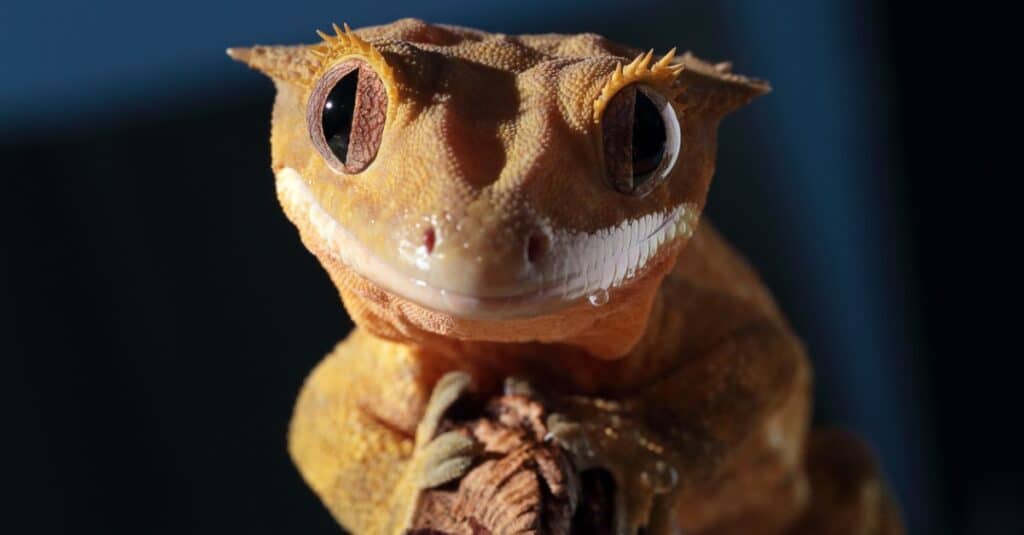
Crested geckos look like they have eyelashes but have neither lashes nor eyelids.
©iStock.com/MattiaATH
Scientific Name and Species
The crested gecko’s scientific name is Correlophus ciliatus, with Rhacodactylus ciliatus being a synonym. Ciliatus comes from the Latin word cilia and means fringe or eyelashes. It describes the crest over the lizard’s eyes that runs down its back. There is only one species and no subspecies.
Evolution
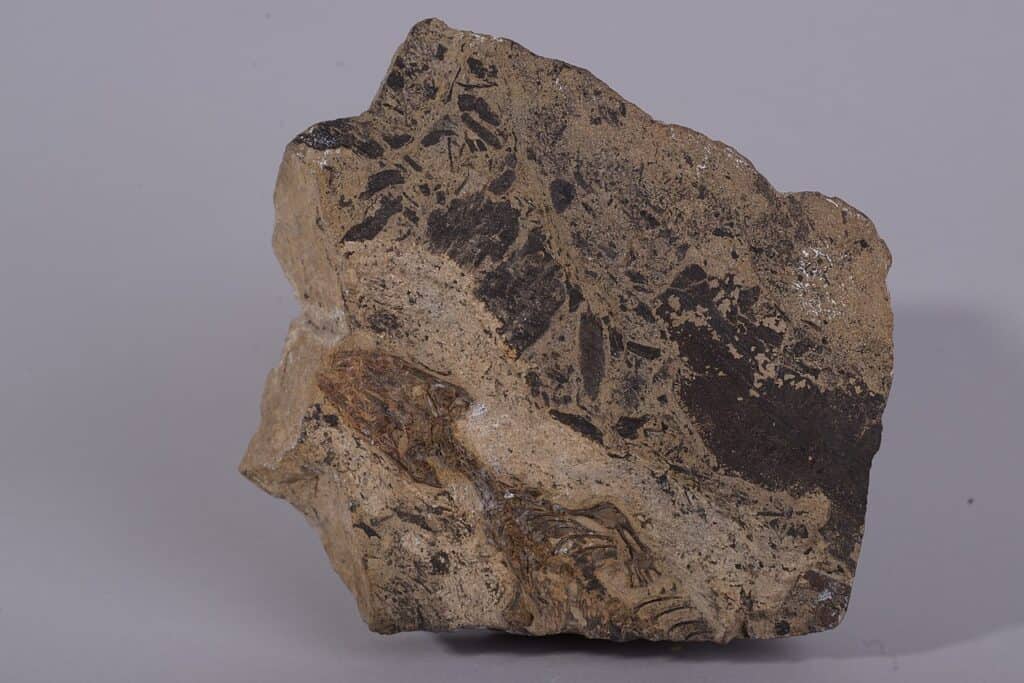
is the oldest-known species of the reptilian order Squamata, making it an ancestor of all lizards and snakes.
All reptiles came from the same ancestors during the Carboniferous Period, 300 – 350 million years ago. Hylonomus, the oldest known fossil of a reptile, is believed to be 315 million years old. Megachirella wachtleri lived 240 million years ago and is one of the most recent fossil discoveries.
It is believed that geckos diverged from other lizards around 200 million years ago. Most lizards and snakes were wiped out with the dinosaurs during the mass extinction at the end of the Cretaceous, 65 million years ago. The lizards that survived – including the crested gecko – have adapted to habitats that are as varied as the thousands of species within this family.
Appearance
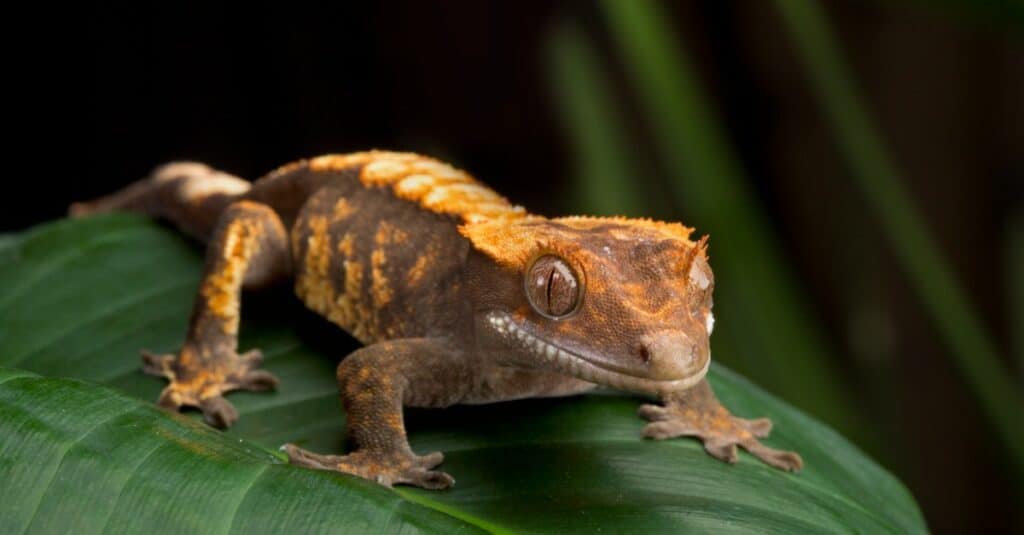
The crested gecko is unable to grow its tail back like other lizards.
©iStock.com/jamcgraw
The crested gecko is a lizard that grows to around six to 10 inches in length, including a four to six-inch-long tail. Its weight is between 1.06 to 1.23 ounces. It has a large head shaped like a triangle and scales that have a texture like beads. The characteristic that gives the gecko its name and is crucial in identification is the continuous, fringed crest that starts above the eyes and looks very much like spiny eyelashes. The spines continue down the sides of the head and body to the base of the tail. Some of these lizards also have stripes down their back.
The gecko lacks eyelids but has clear membranes over its eyes called spectacles, which the lizard needs to lick now and then to keep clean. It also has a tiny ear opening on each side of the head. Four legs have four fingers that are filled with tiny hairs on the end. These hairs let the gecko walk over extremely smooth surfaces such as glass. The toes also have little claws for hanging on. The prehensile tail also has those gripping hairs, or setae at the tip, but the price of this is that the tail can’t grow back when it’s lost. The unusual inability of the tail to grow back is also used in the identification of this gecko.
Wild crested geckos have three color morphs. They are tiger, white-fringed and patternless, and patternless geckos come in solid colors. Breeders have expanded the number of morphs.
Behavior

Crested geckos are solitary except when looking for mates.
©Sefa Kaya/Shutterstock.com
These geckos are active at night and are secretive. They are solitary and like to hide in the undergrowth of the rainforest during the day and climb no more than 10 feet into the canopy during the night to forage and hunt. Their eyes have evolved to see well in the dark, and they can also jump. The tail and feet help them cling to tree branches. They make a chirping sound when looking for mates or confronting would-be predators. They’ll even stand up on their hind legs and gape to frighten an attacker.
Crested geckos are non-threatening to humans, and this and their beauty make them sought after as pets. They do well in a terrarium, and one gecko should be comfortable in a tank size of about 20 gallons.
Habitat
In the wild, the crested gecko is only found in the rainforests of Grande Terre or Isle of Pines in New Caledonia. They are most often found in locations that are between 492 and 3291 feet above sea level.
Diet

Pet crested geckos like to eat live prey just like in the wild.
©iStock.com/MattiaATH
This gecko is an omnivore, so it eats plant and animal material. Its prey includes small arthropods, and it also eats flowers and drinks sap and nectar. In captivity, crested geckos do well with a diet designed for geckos, and they enjoy treats of crickets and cockroaches about three times a week. Ideally, these insects should be offered while they’re still alive so the gecko can satisfy its instinct to hunt. They should be small enough for the lizard to handle and dusted with vitamin powder.
The gecko shouldn’t be fed mealworms as the exoskeleton is hard for them to digest. As for fruit, geckos can be fed pureed baby food or mashed-up bananas, mangos, or stone fruit. Fresh water should always be available.
Predators and Threats
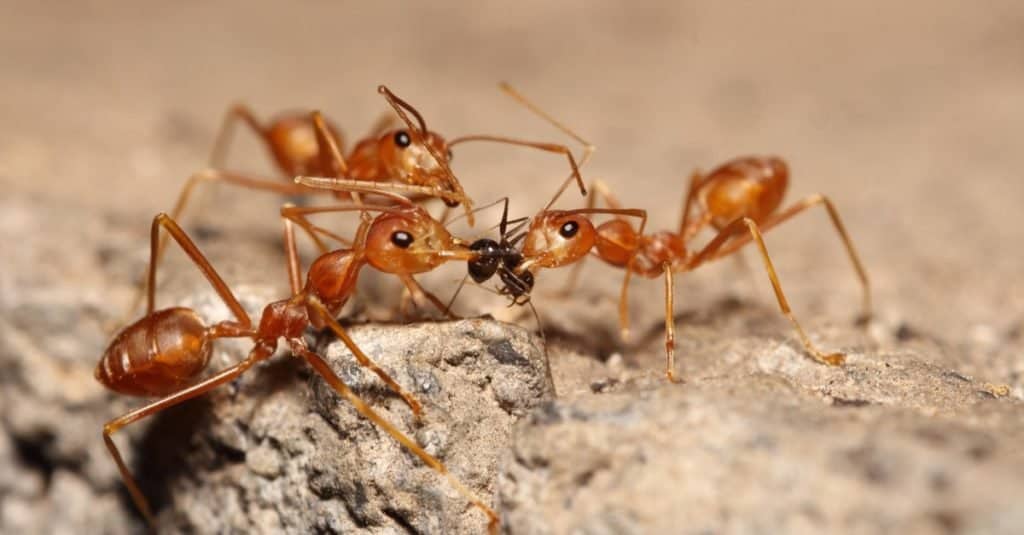
Fire ants live in colonies, which can contain over 200,000 ants – more than enough to overwhelm and kill a crested gecko.
©sarawuth wannasathit/Shutterstock.com
One of the main threats to the crested gecko is the little fire ant, which was introduced to the islands where it lives. Swarms of this dreadful pest not only bite and sting the lizard to death but compete with it for spiders and other invertebrates. The gecko is also endangered by pet dogs and cats, snakes, rats, and its distant cousin, the 14-inch-long Henkel’s giant gecko.
Geckos are subject to parasites such as Entamoeba invadens in the wild, and in captivity, they can suffer from ailments such as mouth rot, respiratory infections, and rashes. Sometimes these disorders are due to the terrarium not being properly maintained, or a tank size that is too small for the gecko or geckos.
Reproduction and Life Cycle
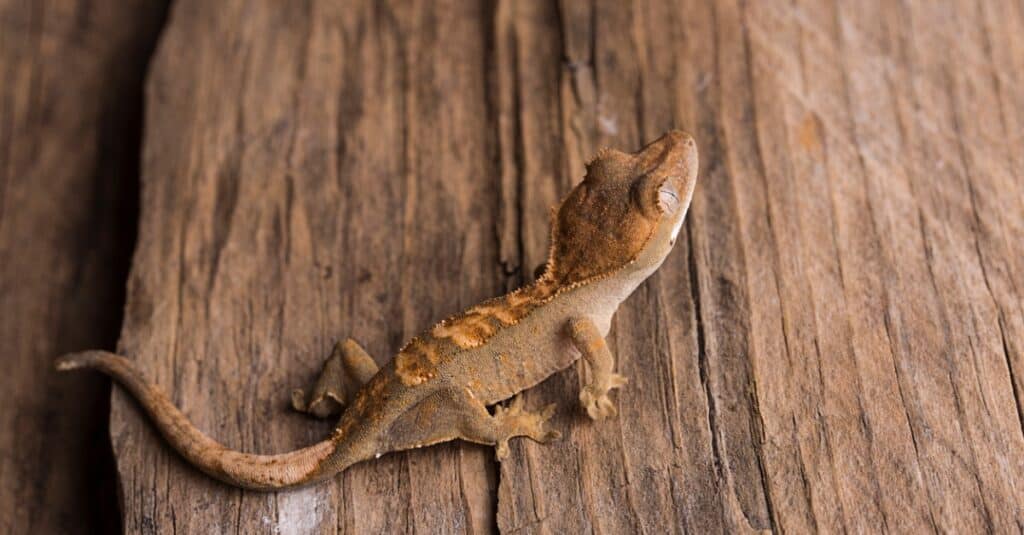
Baby crested geckos are tiny when they hatch – but able to take care of themselves.
©iStock.com/Kaan Sezer
Though the crested gecko only lays two eggs per clutch, it is capable of breeding every four to five weeks, year-round. Males are ready to breed when they’re between nine and 12 months old and females when they’re a little older or weigh at least 1.06 to 1.23 ounces. The male courts her with a sort of twitchy dance, and if she consents, she will keep still. The female starts to lay eggs 30 to 40 days after mating.
In the wild, the female digs a shallow hole away from the sight of predators and lays her eggs in it. Then, she leaves.
The eggs are large in proportion to their mother. They can be 0.43 by 0.94 inches in length and with a weight of between 0.042 and 0.043 ounces. They hatch 60 to 150 days after they are laid. The baby gecko is independent immediately upon hatching and neither parent takes care of it. It gets nutrients from its yolk sac and won’t properly eat until its yolk sac is gone, and it has molted and eaten its skin. The gecko has a lifespan of 20 years or more in captivity, though its lifespan in the wild is unknown.

All of the crested geckos in the wild are found in a space half as big as Rhode Island.
©Jeff McGraw/Shutterstock.com
Population
Though the exact number is unknown, scientists believe that all of the crested geckos in the wild are found in a space half as big as Rhode Island. Still, they are fairly popular as pets. Because of invasive species and habitat disruption, the IUCN lists the conservation status of the gecko as vulnerable.
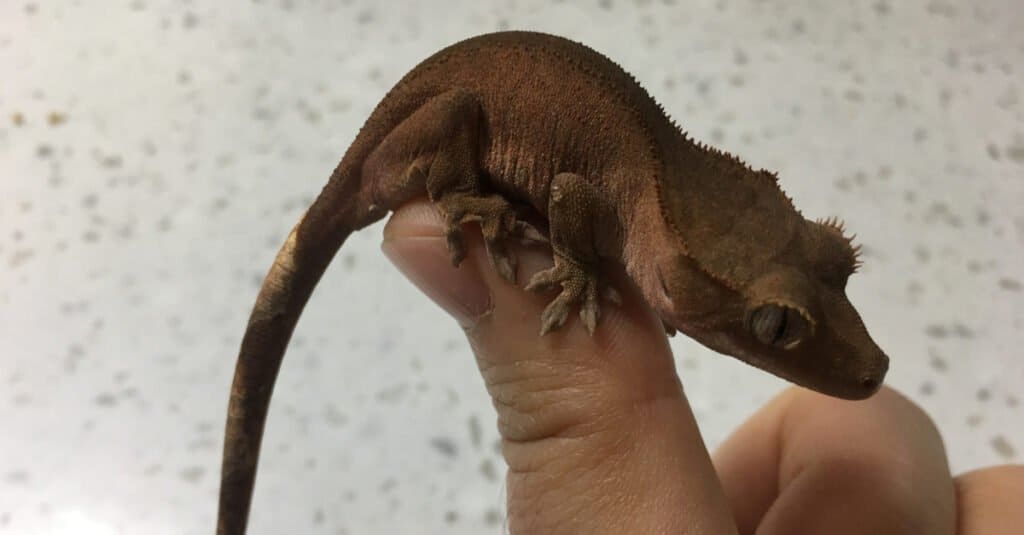
While vulnerable in the wild – crested geckos are fairly popular as pets.
©HAPPYMEME/Shutterstock.com
Crested Gecko FAQs (Frequently Asked Questions)
Are Crested Geckos carnivores, herbivores, or omnivores?
Crested Geckos are omnivores.
Is a crested gecko a good pet?
Crested geckos can make good pets, even for children or people who are new to owning lizards. They are pretty animals and easy to care for.
Do crested geckos like to be held?
Like most reptiles, crested geckos don’t really like to be held. It’s best to admire them from afar.
Is a crested gecko good for beginners?
Because they are clean, docile, and not fussy about their diet, crested geckos are good reptile pets for beginners.
Do crested geckos bite?
They will bite if they feel threatened or stressed, but a calm and happy crested gecko won’t bite. Even if they do bite, their teeth are too tiny to cause damage or even that much pain.
How do I care for a crested gecko?
It’s important to have the right terrarium or tank size for one of these reptiles. A 20-gallon tank or terrarium is the minimum for one adult, and two or three need at least a 29-gallon enclosure. Sphagnum moss, coconut fibers or even newspaper or paper towels make good substrates. Experts warn against putting two males together because they may fight. To find out if you have a male or a female, turn the lizard over, gently. The male will have a bulge near the base of his tail, while the same area on the female will be flat.
The temperature in the enclosure needs to be monitored and regulated. Ideally, it goes from 72 to 80 degrees during the day then drops to no lower than 65 degrees at night. Eyelash geckos do not need as much ultraviolet B light as diurnal lizards, but a bit of UVB is needed to keep them healthy. The enclosure should also have a place for the reptile to hide. Humidity should range between 50 and 70 percent, and this can be had by misting the terrarium with warm water, especially at night.
The lizard should be fed at night. Feed a baby gecko every day, and an adult thrice a week.
How do I mate a crested gecko?
It’s easy. Just put a grown male and female in the same enclosure. An egg box lined with sphagnum moss should be provided. However, you should know that the female can lay eggs every month or so and store sperm. Too much egg-laying can put her at risk of calcium deficiency.
How much is a crested gecko?
A crested gecko can cost between $40 to $150 dollars, and if you want a rare morph, expect to pay even more.
How do I take care of a crested gecko?
Make sure it has enough room, a hiding place, and a good substrate that it won’t eat and is easy to clean. It also needs the right temperature, humidity, and diet.
How long can a crested gecko go without eating?
A crested gecko can go without food for as long as three weeks. However, if the gecko refuses food after two weeks, it’s time to call the exotic pet veterinarian.
Thank you for reading! Have some feedback for us? Contact the AZ Animals editorial team.
Sources
- Wikipedia / Accessed January 27, 2022
- ITIS / Accessed January 27, 2022
- unique wiki Pets / Accessed January 27, 2022
- Reptilia / Accessed January 27, 2022
- thesprucePets / Accessed January 27, 2022
- Reptiles / Accessed January 27, 2022

